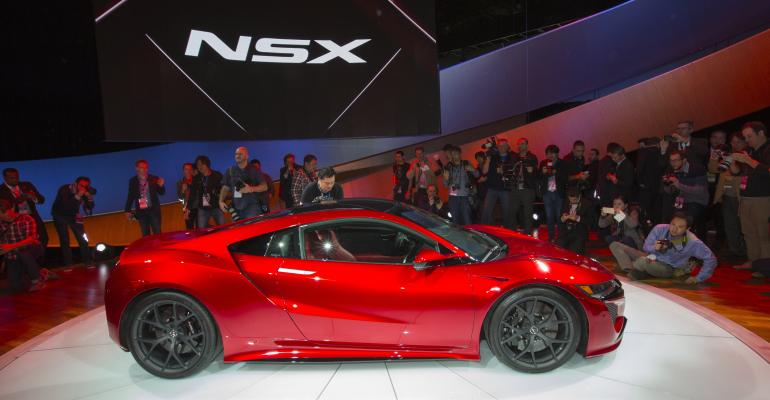DETROIT – Acura has been without an NSX in its lineup for nearly 10 years, and American Honda Executive Vice President John Mendel says the brand probably suffered from it.
But with a new NSX due this summer, he looks forward to wooing back some of the Acura enthusiasts who may have crossed the brand off their list from late 2005, when the first NSX ended production.
“I think that absence maybe will make the heart grow fonder,” Mendel tells WardsAuto in an interview. He likens the NSX’s return to people who don’t show up for parties often, but when they do “they’re well-dressed and it’s a great party.”
Acura expects the NSX to once again cast a design and performance halo on everything the Honda luxury marque does, Mendel says.
The brand admits it lost momentum in recent years.
“We just became vanilla…our styling became a little bland and polarizing,” Acura General Manager Mike Accavitti told the audience at the recent Automotive News World Congress.
Like Mendel, he also sees the NSX as a means to draw buyers to the brand’s other models, which include the ILX, TLX and RLX sedans and MDX and RDX CUVs.
“I don’t need to market NSXs to sell NSXs, but I can market NSXs to sell Acuras,” Accavitti said.
The new NSX, which Mendel says picks up where the original model left off in offering “unattainable supercar performance” for roughly $150,000, will be sold by all 273 of Acura’s U.S. dealers. But don’t look for a shiny display model on every showroom floor.
“Hopefully none of them sit on the showroom floor,” Mendel says, adding he wants Acura to stay one unit behind demand for the model.
While the first-gen NSX launched in 1990 and wasn’t fully revised during its run, he doesn’t see the wait for the third-gen NSX lasting 15 years.
Honda hoped to have the second-generation model on the market sooner than 2015, but had to devote resources to volume players in the wake of the recession and natural disasters in Asia.
“So do you do a next-generation Accord, or do you do an NSX? It’s really about triage and resources,” he says.
Acura sales inched up 1.5% in 2014, harmed by what Mendel calls “a self-inflicted injury on the sedan side,” as the brand sold down the TSX and TL sedans earlier than expected and debuted their replacement, the TLX, later than expected.
Having a full year to sell the new midsize TLX, plus having an updated compact ILX, should improve Acura’s car sales, he says.
The brand also is expected to freshen its CUVs this year. A refreshed RDX will be at next month’s Chicago show.
With Acura selling nearly double the number of CUVs as it did cars in 2014, and CUVs continuing to grow in number and sales volume, Mendel says the brand is looking for “white space” in its CUV lineup.
He calls an Acura version of the soon-to-launch Honda HR-V CUV “potentially the only place you could go” and something the brand is studying.
The HR-V is built on the subcompact Honda Fit’s platform and is smaller than Honda’s wildly successful compact CR-V.
If Acura were to do an HR-V derivative, it would slot below the RDX in size and presumably in price.
The BMW X1 begins at $31,200, while the RDX-competitor X3 is $38,500 to start.





